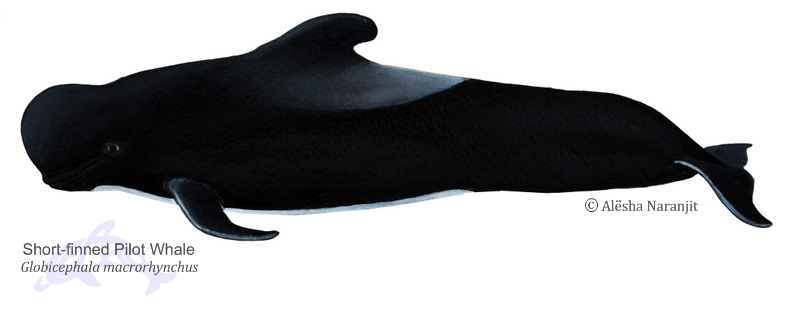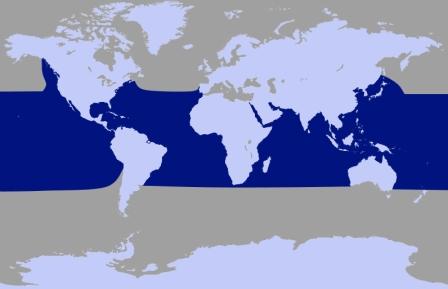Globicephala macrorhynchus

Classification Other Names: Pothead Whale, Pacific Pilot Whale, Shortfin Pilot Whale, Blackfish Suborder: Odontoceti Family: Delphinidae | Description
|
Short-finned Pilot Whale Ecology Range: Tropical and warm temperate waters between 50ºN - 40ºS. Usual Habitat: Generally found in deep waters especially over the continental slope in areas of steep bottom topography. Usual group size: 15 - 50 individuals, sometimes found in groups of up to 100, often with 8 adult females to each adult male. Main Diet: Mainly squid, although they do eat octopus and fish Local population: Unknown | Global range of the Short-finned Pilot Whale  Dark blue areas indicate where Short-finned Pilot Whales are likely to be found |
Protection and Conservation Status
IUCN Conservation Status: Pilot Whales are listed as "Data Deficient" on the IUCN red list. SPAW Protocol: Pilot Whales are cetaceans, which are listed under Annex II of the SPAW protocol. As such they require total protection under article 11 of this protocol which prohibits the "taking, possession, killing and commercial trade of the species, their parts or products". The SPAW protocol was created to help with the implementation and promotion of the Ramsar Convention and the Convention on Biological Diversity. The Annexes of the SPAW protocol can be found here. Local Laws: Cetaceans are protected under the Conservation of Wildlife Act of Trinidad and Tobago which offers protection to all species not listed under the second or third schedules of this act. |
This is currently being researched and written. It will appear here shortly.
References
The above information was obtained from the following sources:
- A Princeton Field Guide: Whales Dolphins and Other Marine Mammals of the World by Hadoram Shirihai and Brett Jarrett (2006)
- Smithsonian Handbooks: Whales Dolphins and Porpoises by Mark Carwardine and illustrated by Martin Camm (2002)
- The Whale and Dolphin Conservation Society's Species Guide at http://www2.wdcs.org/species/index.php
- The IUCN Redlist at http://www.iucnredlist.org
- The SPAW protocol Annexes with links available at http://www.car-spaw-rac.org/?Annexes-of-the-SPAW-Protocol,83
Acknowledgements
We would like to thank the following people for the use of the art work and photographs:
- Alësha Naranjit (Illustration of Short-finned Pilot Whale)